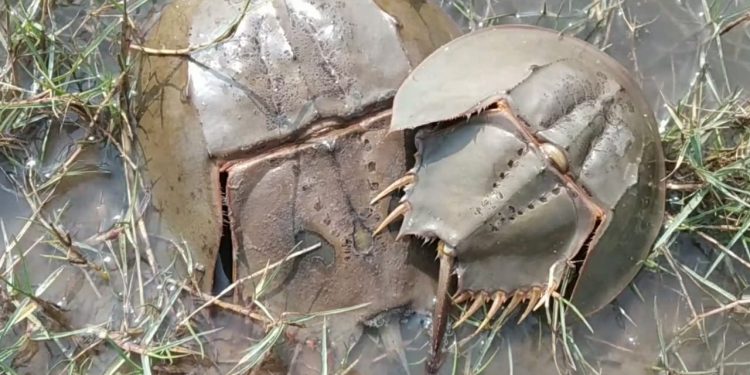Mahakalpara: With the population of horseshoe crabs, a marine creature, fast dwindling, the authorities are yet to implement measures to save the species, sources stated here Sunday. The horseshoe crabs are available in large numbers at the Gahirmatha marine sanctuary in the Kendrapara district. The Zoological Survey of India (ZSI) and the Forest Department have jointly launched geo-tagging of horseshoe crabs in Balasore district but they are yet to take up similar measures in Kendrapara district. Geo-tagging is necessary to track the population and habitat of marine creatures and will also help in increasing their numbers, sources stated.
The horseshoe crab species is available in only a few select places. It is found in Balasore district and the Gahirmatha Marine Sanctuary. The crabs are mostly seen in Hukitola, Shola sea mouth, Launch Ghola, Tanda, Agarnasi, Barunei sea mouth and in the Mahanadi river basin The mating of this creature starts in January and lasts till March. However, during the season thousands of the species die after getting entangled in fishing nets.
Sources informed us that steps should be taken immediately to preserve this particular species of crabs. In January male and female crabs can be seen mating in large numbers in Gahirmatha and the Mahanadi river basin. Male and female crabs can be seen submerged in mud during the mating process. Their mating mainly starts during a full moon night as it plays a significant role in maintaining the biological diversity of the sea. A distinctive feature of the horseshoe crab is that its blood turns blue when exposed to air. This is because the blood contains a copper-based respiratory pigment called ‘hemocyanin’. This pigment is highly in demand in most countries because of its research value and other medicinal purposes.
Sources informed that a litre of horseshoe crab blood costs close to Rs 11 lakh. Several medicines for the treatment of diseases like cancer are produced using horseshoe crab blood. Environmentalist Samarendra Mahali said that the population of horseshoe crabs started declining after the cyclones in 1971 and 1982 and the Super Cyclone in 1999. He said the Forest department should immediately launch efforts for geo-tagging of the marine creatures.
Also Read: Get All Latest Odisha News
The Forest department has completed the geo-tagging of 70 crabs in Balasore district and a similar process should be implemented in Gahirmatha, Mahali added. When contacted, divisional forest officer Sudarshan Gopinath Yadav of Rajnagar Wildlife Division said that they are yet to receive any orders regarding the geo-tagging of horseshoe crabs. “Once we get it, we certainly will implement it,” Yadav added.






































